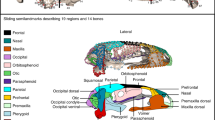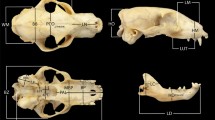Abstract
Paedomorphosis, the presence of ancestral larval and juvenile traits that occur at the descendent adult stage, is an evolutionary phenomenon that shaped morphological evolution in many vertebrate lineages, including tailed amphibians. Among salamandrid species, paedomorphic and metamorphic phenotypes can be observed within single populations (facultative paedomorphosis). Despite wide interest in facultative paedomorphosis and polymorphism produced by heterochronic changes (heterochronic polymorphism), the studies that investigate intraspecific morphological variation in facultative paedomorphic species are largely missing. By quantifying the cranium size and development (bone development and remodeling), we investigated the variation at multiple levels (i.e., between sexes, populations and species) of two facultatively paedomorphic European newt species: the alpine and the smooth newt. The pattern of variation between paedomorphs (individuals keeping larval traits at the adult stage) and metamorphs (metamorphosed adult individuals) varied between species and among populations within a single species. The patterns of variation in size and skull formation appear to be more uniform in the alpine than in the smooth newt, indicating that developmental constraints differed between species (more pronounced in alpine than in smooth newt). Our study shows that the cranial skeleton provides detailed insight in the pattern of variation and divergence in heterochronic polymorphism within and between species and open new questions related to heterochronic polymorphism and evolution of cranial skeleton.



Similar content being viewed by others
References
Alberch P (1983) Morphological variation in the neotropical salamander genus Bolitoglossa. Evolution 37:906–919
Allen CE, Beldade P, Zwaan BJ, Brakefield PM (2008) Differences in the selection response of serially repeated color pattern characters: standing variation, development, and evolution. BMC Evol Biol 8:94
Babik W, Branicki W, Crnobrnja-Isailović J et al (2005) Phylogeography of two European newt species: discordance between mtDNA and morphology. Mol Ecol 14:2475–2491
Bever GS (2009a) Postnatal ontogeny of the skull in the extant North American turtle Sternotherus odoratus (Cryptodira: Kinosternidae). Bull Am Mus Nat Hist 330:1–97
Bever GS (2009b) The postnatal skull of the extant turtle Pseudemys texana (Cryptodira: Emydidae) with comments on the study of discrete intraspecific variation. J Morphol 270:97–128
Bhullar BA (2012) A phylogenetic approach to ontogeny and heterochrony in the fossil record: cranial evolution and development in anguimorphan lizards (Reptilia: Squamata). J Exp Zool Part B Mol Dev Evol 318:521–530
Bhullar BA, Marugán-Lobón J, Racimo F, Bever GS, Rowe TB, Norell MA, Abzhanov A (2012) Birds have paedomorphic dinosaur skulls. Nature 487:223–226
Chippindale PT, Bonett RM, Baldwin AS, Wiens JJ (2004) Phylogenetic evidence for a major reversal in life history evolution in plethodontid salamanders. Evolution 58:2809–2822
Denoël M (2002) Paedomorphosis in the Alpine newt (Triturus alpestris): decoupling behavioural and morphological change. Behav Ecol Sociobiol 52:394–399
Denoël M (2003) How do paedomorphic newts cope with lake drying? Ecography 26:405–410
Denoël M, Joly P (2000) Neoteny and progenesis as two heterochronic processes involved in paedomorphosis in Triturus alpestris (Amphibia, Caudata). Proc R Soc Lond B 267:1481–1485
Denoël M, Poncin P (2001) The effect of food on growth and metamorphosis of paedomorphs in Triturus alpestris apuanus. Arch Hydrobiol 152:661–670
Denoël M, Schabetsberger R (2003) Resource partitioning in two heterochronic populations of Greek Alpine newts, Triturus alpestris veluchiensis. Acta Oecol 24:55–64
Denoël M, Joly P, Whiteman HH (2005) Evolutionary ecology of facultative paedomorphosis in newts and salamanders. Biol Rev Camb Philos Soc 80:663–671
Denoël M, Ivanović A, Džukić G, Kalezić ML (2009) Sexual size dimorphism in the evolutionary context of facultative paedomorphosis: insights from European newts. BMC Evol Biol 9:278
Dingerkus G, Uhler LD (1977) Enzyme clearing of alcian blue stained whole small vertebrates for demonstration of cartilage. Stain Technol 52:229–232
Djorović A, Kalezić ML (2000) Paedogenesis in European newts (Triturus: Salamandridae): cranial morphology during ontogeny. J Morphol 243:127–139
Eastman JM, Storfer A (2011) Correlations of life-history and distributional-range variation with salamander diversification rates: evidence for species selection. Syst Biol 60:503–518
Gould SJ (1977) Ontogeny and phylogeny. Harvard University Press, Cambridge
Hallgrímsson B, Hall BK (2005) In: Hallgrímsson B, Hall BK (eds) Variation: a central concept in biology B. Elsevier Academic Press, New York
Han X, Fu J (2013) Does life history shape sexual size dimorphism in anurans? A comparative analysis. BMC Evol Biol 13:27
Hanken J (1989) Development and evolution in amphibians. Am Sci 77:336–343
Ivanović A, Sotiropoulos K, Furtula M, Džukić G, Kalezić ML (2008) Sexual size and shape evolution in European newts (Amphibia: Caudata: Salamandridae) on the Balkan Peninsula. J Zool Syst Evol Res 46:381–387
Johnson CK, Voss SR (2013) Salamander paedomorphosis: linking thyroid hormone to life history and life cycle evolution. Curr Top Dev Biol 103:229–258
Kalezić ML, Džukić G (1986) The frequent occurrence of paedomorphosis in the smooth newt (Triturus vulgaris) populations from Submediterranean area of Yugoslavia. Amphibia-Reptilia 7:86–89
Kalezić ML, Cvetković D, Djorović A, Džukić G (1996) Alternative life–history pathways: paedomorphosis and adult fitness in European newts (Triturus vulgaris and T. alpestris). J Zool Sys Evol Res 34:1–7
Klingenberg CP (2010) Evolution and development of shape: integrating quantitative approaches. Nat Rev Genet 11:623–635
Laudet V (2011) The origins and evolution of vertebrate metamorphosis. Curr Biol 21:R726–R737
Lebedkina NS (2004) Evolution of the amphibian skull. Pensoft, Sofia
Lynch M, Walsh B (1998) Genetics and analysis of quantitative traits. Sinauer Associates, Sunderland
Mabee PM, Olmstead KL, Cubbage CC (2000) An experimental study of intraspecific variation, developmental timing, and heterochrony in fishes. Evolution 54:2091–2106
Marconi M, Simonetta AM (1988) The morphology of the skull in neotenic and normal Triturus vulgaris meridionalis (Boulenger) (Amphibia, Caudata, Salamandridae). Monit Zool ltal 22:365–396
McNamara KJ (1986) A guide to the nomenclature of heterochrony. J Paleontol 60:4–13
McNamara KJ (2012) Heterochrony: the evolution of development. Evo Edu Outreach 5:203–218
Raff RA (1996) The shape of life: genes, development, and the evolution of animal form. University of Chicago Press, Chicago
Rieppel O (1993) Patterns of diversity in the reptilian skull. In: Hanken J, Hall BK (eds) The skull, vol. II. Patterns of structural and systematic diversity. University Press, Chicago, pp 344–390
Roček Z (1996) Skull of the neotenic salamandrid amphibian Triturus alpestris and abbreviated development in the tertiary Salamandridae. J Morphol 230:187–197
Rohlf FJ (2005) tpsDig. http://life.bio.sunysb.edu/morph/. Accessed 24 Mar 2013
Rose CS (1999) Hormonal control in larval development and evolution—Amphibians. In: Hall K, Wake MH (eds) The origin and evolution of larval forms. Academic Press, San Diego, pp 167–217
Rose CS (2003) The developmental morphology of salamander skulls. In: Heatwole H, Davies M (eds) Amphibian biology, vol. V. Osteology. Surrey Beatty and Sons. Pty. Ltd, Australia, pp 1684–1781
Schluter D (1996) Adaptive radiation along genetic lines of least resistance. Evolution 50:1766–1774
Schoch RR (2010) Heterochrony: the interplay between development and ecology in an extinct amphibian clade. Paleobiology 36:318–334
Semlitsch RD, Wilbur HM (1989) Artificial selection for paedomorphosis in the salamander Ambystoma talpoideum. Evolution 43:105–112
Semlitsch RD, Harris RN, Wilbur HM (1990) Paedomorphosis in Ambystoma talpoideum: maintenance of population variation and alternative life-history pathways. Evolution 44:1604–1613
Shaffer HB (1984) Evolution in a paedomorphic lineage. II. Allometry and form in the Mexican ambystomatid salamanders. Evolution 38:1207–1218
Shaffer HB, Voss SR (1996) Phylogenetic and mechanistic analysis of a developmentally integrated character complex: alternate life history modes in ambystomatid salamanders. Am Zool 36:24–35
Sheets HD (2003) IMP—integrated morphometrics package. http://www3.canisius.edu/_sheets/morphsoft.html. Accessed 24 Mar 2013
Smirnov SV, Vassilieva AB (2003) Skeletal and dental ontogeny in the smooth newt Triturus vulgaris (Urodela: Salamandridae): role of thyroid hormone in its regulation. Russ J Herp 10:93–110
Sotiropoulos K, Eleftherakos K, Džukić G, Kalezić ML, Legakis A, Polymeni RM (2007) Phylogeny and biogeography of the alpine newt Mesotriton alpestris (Salamandridae, Caudata), inferred from mtDNA sequences. Mol Phylogenet Evol 45:211–226
Steinfartz S, Vicario S, Arntzen JW, Caccone A (2007) A Bayesian approach on molecules and behavior: reconsidering phylogenetic and evolutionary patterns of the Salamandridae with emphasis on Triturus newts. J Exp Zool B Mol Dev Evol 306B:139–162
Tills O, Rundle SD, Salinger M, Haun T, Pfenninger M, Spicer JI (2011) A genetic basis for intraspecific differences in developmental timing? Evol Dev 13:542–548
Voss SR (1997) Adaptive evolution via a major gene effect: paedomorphosis in the Mexican axolotl. PNAS 94:14185–14189
Voss SR, Kump KD, Walker JA, Shaffer HB, Voss GJ (2012) Thyroid hormone responsive QTL and evolution of paedomorphic salamanders. Heredity 109:293–298
Wagner GP (1988) The influence of variation and of developmental constraints on the rate of multivariate phenotypic evolution. J Evol Biol 1:45–66
Weins JJ, Hoverman JT (2008) Digit reduction, body size, and paedomorphosis in salamanders. Evol Dev 10:449–463
Weisrock DW, Papenfuss TJ, Macey JR et al (2006) A molecular assessment of phylogenetic relationships and lineage accumulation rates within the family Salamandridae (Amphibia, Caudata). Mol Phylogenet Evol 41:368–383
West-Eberhard MJ (1989) Phenotypic plasticity and the origins of diversity. Annu Rev Ecol Syst 20:249–278
Whiteman HH (1994) Evolution of facultative paedomorphosis in salamanders. Quart Rev Biol 69:205–221
Whiteman HH, Semlitsch RD (2005) Asymmetric reproductive isolation among polymorphic salamanders. Biol J Linn Soc 86:265–281
Whiteman HH, Wissinger SA, Denoël M, Mecklin CJ, Gerlanc NM, Gutrich JJ (2012) Larval growth in polyphenic salamanders: making the best of a bad lot. Oecologia 168:109–118
Wiens JJ (1995) Polymorphic characters in phylogenetic systematics. Syst Biol 44:482–500
Wiens JJ, Bonet RM, Chippindale PT (2005) Ontogeny discombobulates phylogeny: paedomorphosis and higher-level salamander relationships. Syst Biol 54:91–110
Zajc I, Arntzen JW (1999) Phylogenetic relationships of the European newts (genus Triturus) tested with mitochondrial DNA-sequence data. Contrib Zool 68:73–81
Zhang P, Papenfuss TJ, Wake MH, Qu L, Wake DB (2008) Phylogeny and biogeography of the family Salamandridae (Amphibia: Caudata) inferred from complete mitochondrial genomes. Mol Phylogenet Evol 49:586–597
Acknowledgments
We thank two anonymous reviewers for useful comments and suggestions. This work was supported by the Serbian Ministry of Education and Science (Grant No. 173043). MD is a Research Associate at Fonds de la Recherche Scientifique (F.R.S.-FNRS). AI acknowledges financial support from a SyntheSys grant (NL-TAF 3082) and a Naturalis Temminck fellowship, and MD from a F.R.S.-FNRS research grant (J.0008.13) and a Fonds Spéciaux de la Recherche grant from the University of Liège (C-13/03).
Author information
Authors and Affiliations
Corresponding author
Additional information
Communicated by A. Schmidt-Rhaesa.
Electronic supplementary material
Below is the link to the electronic supplementary material.
Three-dimensional view of paedomorphic Ichthyosaura alpestris. (MP4 2609 kb)
Three-dimensional view of paedomorphic Lissotriton vulgaris. (MP4 1492 kb)
Rights and permissions
About this article
Cite this article
Ivanović, A., Cvijanović, M., Denoël, M. et al. Facultative paedomorphosis and the pattern of intra- and interspecific variation in cranial skeleton: lessons from European newts (Ichthyosaura alpestris and Lissotriton vulgaris). Zoomorphology 133, 99–109 (2014). https://doi.org/10.1007/s00435-013-0202-7
Received:
Revised:
Accepted:
Published:
Issue Date:
DOI: https://doi.org/10.1007/s00435-013-0202-7




